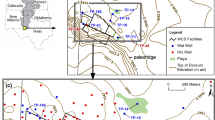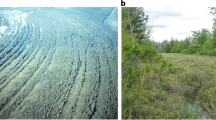Abstract
Beach ridges and wetland swales formed in embayments along Great Lakes shorelines during Holocene lake-level changes. Vegetation differences among swales suggested influence from differing groundwater flow systems. We characterized the hydrology across 79 ridge/swale wetlands in the Manistique/Thompson embayments of Lake Michigan using chemical and physical methods. Cross-sections were built from geologic data, and nested piezometers were installed across three ridges/swales where upwelling was noted. Stainless steel piezometers driven in 30 swales were sampled and water analyzed for specific conductance, alkalinity, and major ions. Surface water from 11 swales was analyzed. Water dominated by Ca-Mg-HCO3 was prevalent across the strandplain, with specific conductance generally less than 100 μS/cm. Conductivity, Ca, Mg, and HCO3 in groundwater were greater at identified groundwater discharges; where an amalgamated beach ridge forms a surficial groundwater divide; and swales nearer Lake Michigan that likely receive greatly mineralized water from a deeper aquifer. Repositioning of the shoreline as the embayments filled over the past 4700 years, coupled with isostatic rebound and changes in lake water levels, altered head differentials and changed the sources of discharge from local, intermediate, and deep flow systems over time. Extant plant communities are consistent with the groundwater dependence of these wetlands.







Similar content being viewed by others
References
Argyilan EP, Johnston JW, Lepper K, Monaghan GW, Thompson TA (2018) Lake-level, shoreline, and dune behavior along the Indiana southern shore of Lake Michigan. In: Florea LJ (ed) ancient oceans, orogenic uplifts, and glacial ice: geologic crossroads in America’s heartland. Geological Society of America Field Guide 51:181–203
Baedke SJ, Thompson TA (2000) A 4,700-year record of lake level and isostasy for Lake Michigan. Journal of Great Lakes Research 26:416–426
Bertrand G, Goldscheider N, Gobat JM, Hunkeler D (2012) Review: from multi-scale conceptualization to a classification system for inland groundwater-dependent ecosystems. Hydrogeology Journal 20:5–25
Boulton AJ, Hancock PJ (2006) Rivers as groundwater-dependent ecosystems: a review of degree of dependency, riverine processes, and management implications. Australian Journal of Botany 54:133–144
Burkett VR, Wilcox DA, Stottlemyer R, Barrow W, Fagre DB, Baron J, Price J, Nielson JL, Allen C, Peterson DL, Ruggerone G, Doyle T (2005) Nonlinear dynamics in ecosystem response to climatic change: case studies and management implications. Ecological Complexity 2:357–394
Carlson Mazur ML, Wiley MJ, Wilcox DA (2014) Estimating evapotranspiration and groundwater flow from water-table fluctuations for a general wetland scenario. Ecohydrology 7:378–390
Cherkauer DS, McKereghan PF (1991) Ground-water discharge to lakes: focusing in embayments. Ground Water 29:72–80
Coordinating Committee on Great Lakes Basic Hydraulic and Hydrologic Data (2001) Apparent vertical movement over the Great Lakes – revisited. IL and Cornwall, ON, Chicago
Crowe AS, Shikaze SG (2004) Linkages between groundwater and coastal wetlands of the Laurentian Great Lakes. Aquatic Ecosystem Health and Management 7:199–213
Doss PK (1993) The nature of a dynamic water table in a system of non-tidal, freshwater coastal wetlands. Journal of Hydrology 141:107–126
Eamus D, Froende R (2006) Groundwater-dependent ecosystems: the where, what, and why of GDEs. Australian Journal of Botany 54:91–96
Eamus D, Fu B, Springer AE, Stevens LE (2016) Groundwater-dependent ecosystems: classification, identification techniques, and threats. In: Jakeman AJ, Barreteau O, Hunt RJ, Rinaudo JD, Ross A (eds) Integrated groundwater management: concepts, approaches, and challenges. Springer Open, London, pp 313–346
Euliss NE Jr, Mushet DM, Newton WE, Otto CRV, Nelson RD, LaBaugh JW, Scherff EJ, Rosenberry DO (2014) Placing prairie pothole wetlands along spatial and temporal continua to improve integration of wetland function in ecological investigations. Journal of Hydrology 513:490–503
Harvey FE, Ayers JF, Gosselin DC (2007) Ground water dependence of endangered ecosystems: Nebraska’s eastern saline wetlands. Ground Water 45:736–572
Hatton T, Evans R (1998) Dependence of ecosystems on groundwater and its significance to Australia. Occasional paper 12/98, land and water resources Research and Development Corporation, Canberra.
Hayashi M, Rosenberry DO (2002) Effects of ground water exchange on the hydrology and ecology of surface water. Ground Water 40:309–316
Holzer TL, Noce TE, Bennett MJ (2011) Liquifaction probability curves for surficial geologic deposits. Environmental and Engineering Geoscience 17:1–21
Humphreys WF (2009) Hydrology and groundwater ecology: does each inform the other? Hydrogeology Journal 17:5–21
Johnston JW, Baedke SJ, Booth RK, Thompson TA, Wilcox DA (2004) Late Holocene lake-level variation in southeastern Lake Superior: Tahquamenon Bay, Michigan. Journal of Great Lakes research 30 Supl(1):1–19.
Kehew AE, Passero RN, Krishnamurthy RV, Lovett CK, Betts MA, Dayharsh BA (1998) Hydrogeochemical interaction between a wetland and an unconfined glacial drift aquifer, southwestern Michigan. Ground Water 36:894–856
Klove B, Ala-aho P, Bertrand G, Boukalova Z, Erturk A, Goldscheider N, Ilmonen J, Karakaya N, Kupfersberger H, Kuoerner J, Lundberg A, Mileusnic M, Moszczynska A, Muotka T, Preda E, Rossi P, Siergieiev D, Simek J, Wachniew P, Angheluta V, Widerlund A (2011) Groundwater-dependent ecosystems. Part I: hydroecological status and trends. Environmental Science & Policy 14:770–781
Loheide SP, Deitchman RS, Cooper DJ, Wolf EC, Hammersmark CT, Lundquist JD (2009) A framework for understanding the hydroecology of impacted wet meadows in the Sierra Nevada and Cascade ranges. Hydrogeology Journal 17:229–246
Mainville A, Craymer MR (2005) Present-day tilting of the Great Lakes region based on water level gauges. GSA Bulletin 117:1070–1080
Meyboom P (1967) Mass-transfer studies to determine the groundwater regime of permanent lakes in hummocky moraine of western Canada. Journal of Hydrology 5:117–142
Murray BR, Zeppel MJB, Hose GC, Eamus D (2003) Groundwater-dependent ecosystems in Australia: it’s more than just water for rivers. Ecological Management & Restoration 4:110–113
Shedlock RJ, Wilcox DA, Thompson TA, Cohen DA (1993) Interactions between ground water and wetlands, southern shore of Lake Michigan, USA. Journal of Hydrology 141:127–155
Singer DK (1996) Autogenic and allogenic influences on long-term vegetation dynamics of a wetland chronosequence in northern Michigan. M.S. thesis, Flagstaff, AZ, Northern Arizona University
Swink F, Wilhelm G (1979) Plants of the Chicago region. The Morton Arboretum, Lisle, IL
Thompson TA, Baedke SJ (1995) Beach-ridge development in Lake Michigan—shoreline behavior in response to quasi-periodic lake-level events. Marine Geology 129:163–174
Thompson TA, Baedke SJ (1997) Strandplain evidence for late Holocene lake-level variations in Lake Michigan. Geological Society of America Bulletin 109:666–682
Thompson TA, Johnston JW, Lepper K (2014) The contemporary elevation of the peak Nipissing phase at outlets of the upper Great Lakes. Geological Society of America Special Papers 508:15–29
Tóth J (1963) A theoretical analysis of groundwater flow in small drainage basins. Journal of Geophysical Research 68:4795–4812
van der Kamp G, Hayashi M (2009) Groundwater-wetland ecosystem interaction in the semiarid glaciated plains of North America. Hydrogeology Journal 17:203–214
VanderMuelen J (1984) Salt and road deicing on the Michigan state highway system. Legislative Service Bureau, Lansing, MI
Voss EG, Reznicek AA (2012) Field manual of Michigan Flora. University of Michigan Press, Ann Arbor, MI
Wilcox DA, Shedlock RJ, Hendrickson WH (1986) Hydrology, water chemistry, and ecological relations in the raised mound of Cowles bog. Journal of Ecology 74:1103–1117
FD Wilde (2010) Water quality sampling by the U.S. Geological Survey: standard protocols and procedures. U.S. Geological Survey Fact Sheet 2010–3121
TC Winter (1976) Numerical simulation analysis of the interaction of lakes and ground water. U.S. Geological Survey Professional Paper 1001
Winter TC (1989) Hydrologic studies of the wetlands in northern prairie. In: van der Valk AG (ed) Northern prairie wetlands. Iowa State University Press, Ames, IA, pp 16–54
Winter TC, Rosenberry DO (1995) The interaction of ground water with prairie pothole wetlands in the cottonwood Lake area, east-Central North Dakota, 1979-1990. Wetlands 15:193–211
TC Winter, JW Harvey, OL Franke, WM Alley (1998). Ground water and surface water: a single resource. U.S. Geological Survey Circular 1139
Acknowledgments
Water sample and field data collections were assisted by Joseph Bell, Rachel (Posner) Chapman, and Paige Baedke. The Piper plot was prepared by Jeffrey Wilcox, who also provided a review of the manuscript prior to submission. Piezometer installation, surveying, and measurement at S58 to S60 were assisted by Michael Sweat. This study was funded by the U.S. Geological Survey Global Climate Change Program in a grant to the USGS Great Lakes Science Center.
Author information
Authors and Affiliations
Corresponding author
Additional information
Publisher’s Note
Springer Nature remains neutral with regard to jurisdictional claims in published maps and institutional affiliations.
Rights and permissions
About this article
Cite this article
Wilcox, D.A., Baedke, S.J. & Thompson, T.A. A Complicated Groundwater Flow System Supporting Ridge-and-Swale Wetlands in a Lake Michigan Strandplain. Wetlands 40, 1481–1493 (2020). https://doi.org/10.1007/s13157-020-01302-8
Received:
Accepted:
Published:
Issue Date:
DOI: https://doi.org/10.1007/s13157-020-01302-8




